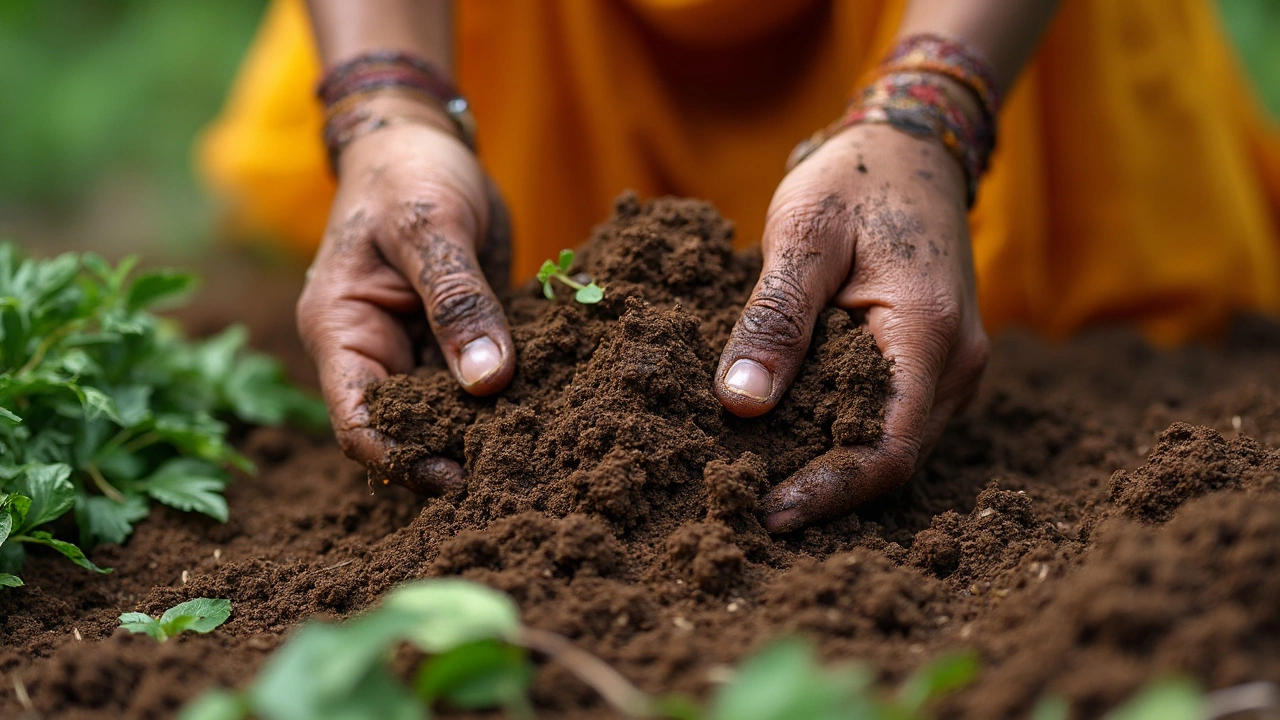Heavy garden soil has a lousy reputation for a reason—it turns into bricks when it’s dry and a sticky, shoe-grabbing mess after rain. If you can roll your soil into a sausage shape and it stays solid, you’re dealing with the classic dense stuff that suffocates plant roots and drains slower than paint dries.
Don’t blame yourself if you’ve battled with stunted tomatoes or angry carrots in this type of ground. The good news? You can fix it. Right now, your soil is screaming for air and organic matter. Skip the long lectures about ancient soil science; what matters is getting more ‘crumbly chocolate cake’ texture and letting water drain instead of pooling up like a swamp.
Nothing changes overnight, but with the right tweaks, you and your plants can start winning this fight. I’ll share what’s worked in my own backyard (Rufus, my dog, approves), so you can stop turning your garden beds into test plots for failed experiments. It’s easier than you think.
- Spotting Heavy Soil Problems
- Game-Changing Amendments
- How to Mix It All In
- Mistakes People Make
- Simple Maintenance for Healthy Soil
Spotting Heavy Soil Problems
Wondering if you have heavy soil? Start with a shovel test. If turning over a scoop feels like a workout, or the soil sticks to your tools in globs, you’re in clay territory. When wet, heavy garden soil is gummy and slick—sometimes it squishes out water when squeezed. Dry, it sets up hard like a sidewalk. Classic signs include pools of water hanging around after rain, plants that barely grow or look yellow, and roots that stay close to the surface because they can’t push through the dense ground.
Plants in heavy soil often struggle with stunted growth. Sometimes grass gets patchy or moss moves in, since both love soggy spots. If you dig down and find gray or blue streaks, that means water isn’t draining fast enough—which pretty much chokes roots. The lack of air pockets below ground is the real enemy here. Roots need air just as much as water, and when they don’t get enough, garden beds start to smell bad, sometimes even like rotten eggs.
A quick way to be sure? Do the soil sausage test. Grab a handful, add a bit of water, and roll it between your hands. If it forms a long, solid worm without breaking, you have more clay than you’d probably like. Sandy or loamy soils just fall apart. Here’s a handy table for the quick checks:
| Check | What You See in Heavy Soil |
|---|---|
| After Rain | Puddles stick around, slow to dry |
| Dig Test | Soil super sticky or hard as a rock |
| Plant Growth | Plants stunted, yellow, unhealthy |
| Soil Smell | Sometimes sour or rotten egg odor |
| Sausage Roll | Forms a solid worm, doesn’t crumble |
If two or more match your yard, it’s time to roll up your sleeves and tackle soil amendment. Identifying the problem is step one—solving it comes next, and it’s not as tough as you might think.
Game-Changing Amendments
If you want to amend heavy soil, not just any fix will do. There are some real MVPs in the soil improvement world, and a lot of folks get these wrong. Look for stuff that ups drainage, boosts air, and breaks up that tough clumping. Here are the big winners for garden soil improvement:
- Compost: Classic move right here. Finished compost breaks up clay, feeds microbes, and gives roots some easy pathways. Spread it 2-3 inches deep over your beds, and work it into the top 6-8 inches.
- Leaf Mold: Don’t toss those fall leaves—pile them up, let them rot for a year, and you’ll have a crumbly, sponge-like material that’s pure gold for heavy soil.
- Wood Chips and Bark Fines: These help the surface, keeping water from pounding your soil into a brick and slowly breakdown, feeding worms. Go easy mixing these deep in beds—better as a mulch or top-dressing.
- Aged Manure: Not fresh—nobody wants to burn their plants. Composted manure adds nutrients, organic matter, and helps get that fluffier texture.
- Pine Fines or Peat Moss: Peat can make the soil more acidic, so watch what you plant—great for blueberries, less so for veggies. Pine fines are gentler but still get the job done for structure.
- Gypsum: If you’re stuck with clay and have hard water, a few handfuls of gypsum per square meter can help break up clods without messing with your soil’s pH. This one’s a game-changer in some parts of the country (think Texas or the Midwest).
Stay away from sand unless you want something that resembles concrete after rain. That’s probably the most common rookie mistake. Mixing the right organic matter is what actually fixes heavy soil—not just moving it around or topping it with more dirt.
| Amendment | Best Use | Speed of Results |
|---|---|---|
| Compost | All heavy soils | Fast |
| Leaf Mold | Moisture retention | Slow–med |
| Wood Chips | Surface mulch | Medium |
| Aged Manure | Nutrients + texture | Medium |
| Pine Fines/Peat | Soil structure | Medium |
| Gypsum | Clay breakup | Fast (if needed) |
If you’re consistent, you’ll notice a change after one season. Your plants will root deeper, water won’t hang around, and Rufus might even stop tracking so much mud inside. One last tip—set a reminder to re-up your amendments every year or so, because broken-down stuff needs a top-up to keep working hard for your garden.

How to Mix It All In
Getting those amendments deep into your heavy garden soil is where the magic happens. Just dumping a pile of compost on top and hoping for the best won’t cut it, especially with stubborn amend heavy soil types like clay. You need to mix, not layer. Here’s how to do it right without making things complicated—or hurting your back.
First, choose your tools. For small beds, a sturdy garden fork works better than a shovel because it lifts and breaks clumps without turning the whole thing into soup. For bigger areas, renting a rototiller for a couple of hours is worth every penny, but don’t go wild with it—over-tilling can actually compact the ground below.
Ready to improve your garden soil? Follow these steps:
- Spread your organic matter (compost, rotted manure, leaf mold) across the top at 2–3 inches thick. More isn’t always better—piling it on makes mixing harder later.
- Use your fork or tiller to break up the soil to about 8 inches deep, working the amendments through every layer. Don’t just skim the surface. The roots need that good stuff where they actually grow.
- If your soil is really packed or full of big clods, go through it again. Ignore perfection—just break up anything bigger than a golf ball.
- Water the area well after mixing. Moisture helps the soil microbes get to work, breaking down what you added and opening up the soil structure.
Here’s a quick breakdown of how much you might need for a standard 100 sq ft bed:
| Material | Amount per 100 sq ft |
|---|---|
| Compost | 4–6 cubic feet |
| Rotted manure | 3–5 cubic feet |
| Leaf mold | 3–5 cubic feet |
Avoid mixing in sand unless you already have a huge supply of organic matter; sand plus clay equals concrete, and that’s not the fix you want. Stick with the proven soil amendment tips your plants actually benefit from.
One last tip—don’t walk all over the freshly-mixed beds, especially right after rain. You’ll squash all that good texture you just worked hard to create! Place boards or stepping stones if you need to reach across, so your fix clay soil work doesn’t go to waste.
Mistakes People Make
It's way too easy to go down the wrong path with amend heavy soil projects. We've all done it. Here are the classic blunders and how not to repeat them.
- Dumping sand into clay: It sounds like a shortcut, but sand plus clay makes soil hard as concrete. You'd end up with a bed that's perfect for a brick factory, not your veggies.
- Not adding enough organic matter: A shovel or two of compost isn't enough if you're working with heavy soil. Aim for at least a couple inches thick across the whole bed. Skimping here means you'll barely notice a change.
- Piling on chemical fertilizers: Heavy soils trap nutrients well but they also hold onto salts from fertilizers. That can actually hurt your plants more than help, especially if you rely on fast-release options.
- Tilling when the soil's wet: This one’s a killer. Working heavy soil when it’s wet creates even tighter clumps, basically undoing all your hard work at once. Wait until it’s crumbly and only a bit moist.
- Overlooking drainage: You can add all the soil amendment tips in the world, but if water can’t drain, roots suffocate. Some folks forget to break up the bottom of their beds or miss out on raised options when they really need them.
Check these numbers out: a recent Cornell University trial found that gardens barely improved when people added less than 10% organic matter by volume to their soil. But when they pushed that up to 20%, drainage and plant health shot up by almost double. So don’t be stingy with the good stuff.
The last thing: don’t assume this is a one-and-done deal. Heavy soil fights back. Keep amending, keep checking the texture, and your plants will actually thank you.

Simple Maintenance for Healthy Soil
Keeping your garden soil healthy isn’t a one-time thing—it’s all about the little habits you build through the year. Once you’ve managed to amend heavy soil and see it getting looser, you’re not off the hook. Regular tweaks keep things on track and stop your ground from turning back into that stubborn, compacted mess.
- Add organic matter every year. Even if you worked in compost or well-rotted manure last season, your soil will chow through it fast. Throw down a couple of inches of compost each spring or fall. The more you feed your soil, the better it performs.
- Don’t walk on wet beds. Heavy garden soil is especially easy to squash, so avoid stepping on it when it’s wet. Lay down stepping stones if you need to reach the middle of your beds, or learn to stretch!
- Use mulch. Besides looking tidy, mulch keeps moisture steady and adds organic material as it breaks down. Grass clippings, shredded leaves, and straw work great for most gardens.
- Grow cover crops in winter. Got a patch you won’t use over the cold months? Throw down a quick cover crop like clover or rye. They aerate the ground naturally, prevent erosion, and will break down to boost soil structure come spring.
- Check drainage now and then. Dig a hole about a foot deep and fill it with water. If it takes longer than 4 hours to drain, your soil still needs help—keep adding soil amendment tips like compost or sand.
Don’t forget, plant roots do a lot of the work for you. Rotate crops and swap out deep-rooted veggies like carrots or daikon now and then to open up those tough layers. If you stick with these habits, your garden soil improvement plan pays off year after year, with less work from you.
| Maintenance Task | How Often |
|---|---|
| Add Compost | Once or twice a year |
| Mulch Beds | Spring or Fall |
| Check Drainage | Every few months |
| Plant Cover Crops | Late Fall |
Simple, right? Keep at it and even the heaviest soil starts to act more like that rich, crumbly earth you see in garden magazines.

